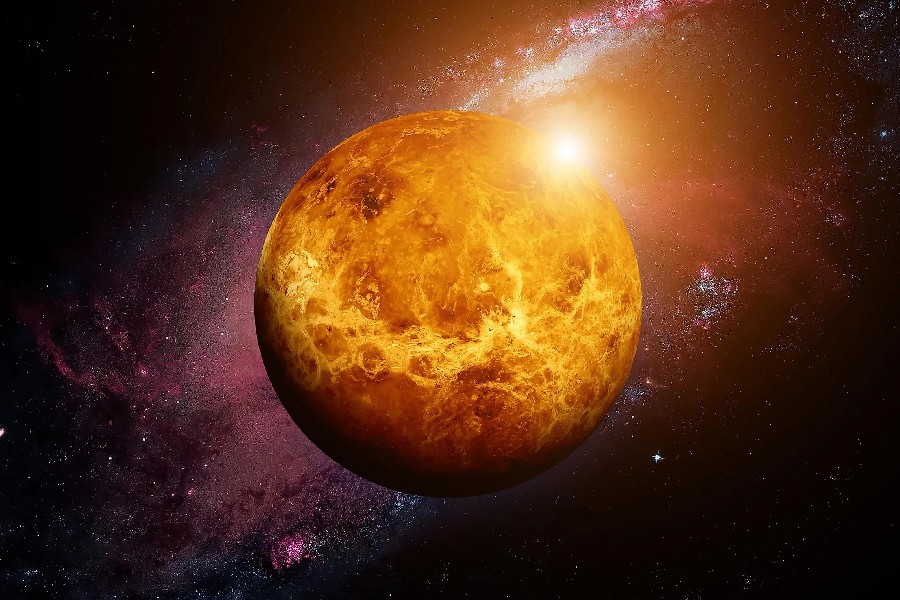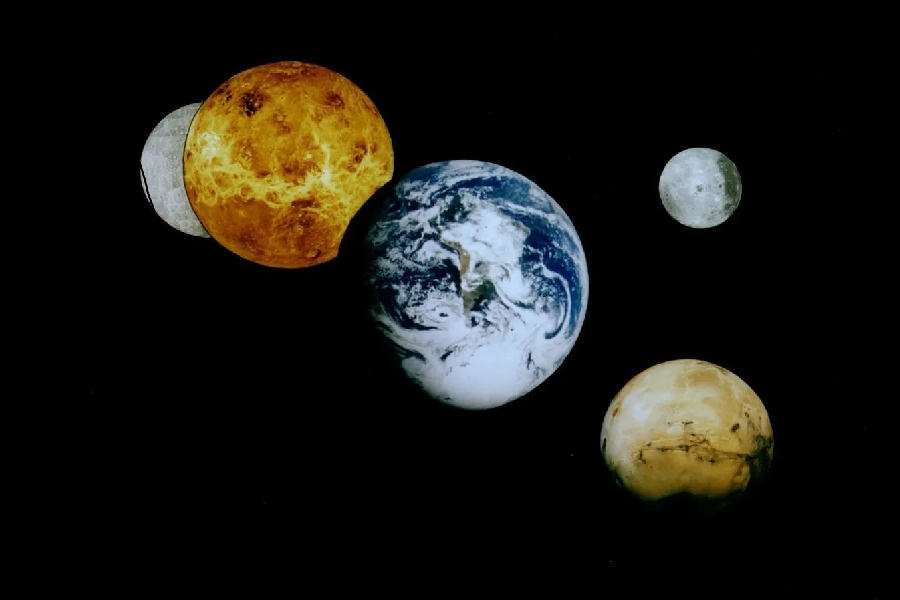Our solar system hosts planets with vastly different surfaces. One world claims exceptional heat and is titled as the hottest planet of our solar system. Orbiting near the Sun, immense temperatures shape its scorched landscape beyond any other.
This intensely hot inferno defies the very conditions allowing life in the wider system. Its volatile nature is unmatched among known worlds near and far. So, what is the hottest planet in our solar system?
Well, some logic might suggest that the planet closest to the Sun should be the hottest, however, the truth is slightly different than that. Let’s uncover the truth in the following!
What Is the Hottest Planet in Our Solar System?
So, what is the hottest planet in our solar system? Venus is the hottest planet by far, with average temperatures of a sweltering 867°F (464°C). This is hot enough to melt lead. This extreme heat comes from an intense greenhouse effect. This effect is caused by Venus’ 96.5% dense CO2 atmosphere.
This atmosphere traps incoming solar radiation and prevents heat from escaping. This causes a runaway greenhouse effect. Venus’ hot interior core adds supplemental heating. This pushes temperatures beyond solar input alone.
Venus greatly exceeds other inner and outer planets in heat and hostility to life. No other world comes close to Venus’ extremes. This makes Venus uniquely torrid in our solar system.

Factors Influencing Planetary Temperatures
Distance from the Sun
Planets closer to the Sun receive higher sunlight intensity that contributes to surface heating. For example, Mercury orbits closest to the Sun, resulting in immense solar intensity exposure.
However, other variables like atmospheric thickness also factor hugely in heat retention on the world. So, while proximity affects temperatures, the closest planet is not necessarily the hottest.
Mercury and Venus, although small, have high temperatures as heat absorption exceeds radiation.
In contrast, distant planets receive lower solar intensity. Less heat is absorbed, causing very low temperatures.
Atmosphere composition and greenhouse effect
Planetary atmospheres regulate surface temperatures by trapping heat through the greenhouse effect. Gasses like CO2 and methane greatly increase this greenhouse effect and surface heating when prevalent in atmospheres. More of these greenhouse gasses cause more heat-trapping.
For instance, Venus has an extremely dense 96.5% CO2 atmosphere, producing an extreme greenhouse effect. This results in staggeringly high 867°F (464°C) temperatures despite being further from the Sun than Mercury.
Venus – The Hottest Planet in Our Solar System
Venus is considered Earth’s twin but has surface temperatures hot enough to melt lead. Studying Venus’ extremes helps us understand planetary habitability limits. No other planet comes remotely close in terms of heat.
Orbital proximity cannot fully explain Venus’ temperatures. Its dense atmosphere causes an intense greenhouse effect, driving heat to extremes through runaway heating. Understanding this provides insights into maintaining habitable conditions.
Orbital characteristics and proximity to the Sun
Venus orbits at 0.72 AU from the Sun. This distance is just slightly closer than Earth’s orbital distance. In terms of solar proximity, Venus receives only around twice as much sunlight as Earth.
This minor 25% increase alone cannot account for Venus having temperatures over 750°F (400°C) higher than Earth’s. Solar distance explains only a small part of Venus’ heat.
Venus’ orbit also has very low eccentricity, meaning it maintains a near-constant distance from the Sun as it revolves. This distance does not fluctuate much throughout its year relative to most other planets.
Atmosphere composition and surface features
Venus has an incredibly dense atmosphere, almost completely composed of 96.5% carbon dioxide. This atmosphere’s composition far exceeds Earth’s 0.04% CO2 levels.
This causes an intense greenhouse effect on Venus. Solar energy passes through the atmosphere, but the heat gets trapped by the thick, insulating CO2 layer.
The Venusian surface is dry and rocky, with few impact craters due to extensive volcanic resurfacing. Surface interaction with the heat-trapping atmosphere further elevates temperatures.
Extreme temperatures on Venus
Despite being further out than Solar System inner planets, Venus has vastly higher temperatures. Venus’ average 750°F (400°C) far exceeds closer-in Mercury’s 338°F (170°C) peak daytime highs.
Venus does receive more total solar input than Earth. But its extreme greenhouse effect is the primary driver of heating far beyond what sunlight alone provides.
No other planet comes even remotely close to Venus in terms of heat. Its dense heat-trapping atmosphere enables Venus to be the most torrid world by far, even with its greater solar distance.

Comparative Analysis With Other Planets
Venus vs. Mercury
Is Mercury hotter than Venus? It isn’t. Mercury is the closest planet to the Sun, with an orbital distance of 0.4 AU. Despite this, Mercury has average temperatures of 332°F (167°C) – far below Venus.
Mercury lacks an atmosphere and has a minimal greenhouse effect. Almost no heat gets trapped, offsetting proximity, as the planet quickly radiates energy back into space after sundown.
Mercury – Closest to the Sun but not the hottest
As mentioned previously, Mercury orbits the Sun at just 0.4 AU, but with minimal atmosphere and no significant greenhouse gasses, absorbed heat quickly radiates back into space. This keeps Mercury cooler than Venus.
Instead, Mercury has extreme temperature shifts between day (806°F) and night (-292°F) as heat spikes near perihelion when incoming solar radiation briefly intensifies from proximity.
Venus vs. Mars
Is Venus hotter than Mars? It surely is! Mars has an extremely thin atmosphere, comprising >95% CO2 but at only 1% the density of Earth’s atmosphere. This allows heat to easily radiate into space.
With weak greenhouse heating and 50% further orbital distance than Venus, Mars maintains an average temperature of -76°F (-60°C) compared to torrid Venus despite having more atmospheric CO2.
Mars – Cold temperatures and thin atmosphere
Orbiting 50% further than Venus at 1.5 AU, Mars receives around half as much sunlight. And what little solar heat Mars absorbs is not trapped by its wispy, mostly CO2 atmosphere, which is only 1% as dense as Earth’s.
This combination allows heat to easily radiate into space, giving Mars an average frigid temperature of -76°F, over 932°F colder than Venus.
Planetary Temperatures Across the Solar System
Gas giants, Earth, and beyond
The outer gas giants do not have extreme greenhouse effects. Their great distances from the Sun offset internal heating, making their atmospheres very cold despite their composition.
Earth nearly matches Venus in size and atmosphere density. But with 400 times less greenhouse CO2, temperatures average a stable 59°F (15°C) instead of a hostile 867°F like torrid Venus.
Exoplanets orbiting close to their stars likely experience Venus-like runaway greenhouse effects if water vapor adds to CO2 heating. This expands our understanding of planetary habitability.
Conclusion
Our exploration has revealed that Venus has exceptionally high temperatures unrivaled by other worlds. Venus reaches average temperatures of 867°F – hot that exceeds even that of Mercury. We hope this article has cleared any doubts regarding the question of what is the hottest planet in our solar system.
Venus’s runaway greenhouse effect from its thick, heat-trapping CO2 atmosphere drives surface heating beyond what sunlight alone provides. Venus’ extremes showcase conditions limiting habitability.
Studying Venus, the hottest planet, and why it’s so different from Earth provides insights into maintaining planetary habitability. Discovering each world’s uniqueness aids cosmic understanding.
